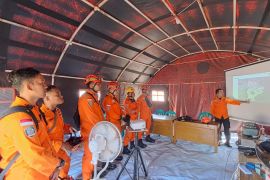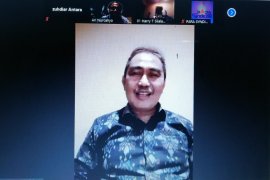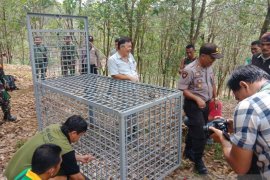Water hyacinth, a very aggressive invader which can form thick mats, is invasively present in wetlands and swampy shorelines around Lake Tondano and is spread widely.Jakarta (ANTARA News) - The lives of 17 residents of Minahasa District in North Sulawesi Province were at risk after they were trapped by water hyacinths (Eichhornia crassipes) in Lake Tondano on Monday.
The morning turned tragic, and the 17 residents of Minahasa District could not believe it was just the ordinary moments they had during their excursion on Likri isle in Lake Tondano.
Lake Tondano, the largest in North Sulawesi, has been a long time favorite for locals and tourists alike.
Cradled in a natural basin at 600 meters above sea level and surrounded by Mounts Tondano, Kaweng, Lembean, Tampusu, and Masarang, the lake is a cool and scenic retreat away from the hot and humid coast.
But the boat that the 17 residents boarded for excursion in the lake appeared to have been blocked by the weeds as they were attempting to make their way out of the water hyacinths.
They were trapped in the middle of the lake since Monday morning until 2 am local time on Tuesday before they were finally rescued by a joint team of rescuers.
"The evacuation process lasted until Tuesday morning," Manado National Search and Rescue Office spokesman Jefry Mewoh remarked in Manado on Tuesday.
Jefry stated that Lake Tondano was just 5 kilometers from Tomohon, or 30 kilometers from Manado, and could be easily explored within a day.
Exploring the lake is a lovely way to spend the day, because the entire lake can be circumnavigated by road.
Covering an area of 4,278 hectares, the lake sprawls across three districts, supporting rice and vegetable crops, fishing, and tourism.
Visiting the lake is really a precious moment. With about an hour journey from the city of Manado via road and winding up in the mountains and the green crops, the visitors can arrive at the edge of the cool air of Tondano.
However, the surface of the lake has been covered and silted up by water hyacinths. The North Sulawesi provincial government is looking for the best possible solution to handle the problem.
The local government should be committed to handling the problem that has contributed to the silting up of the lake.
In 2013, a team of researchers from Germany came to Manado to do some research on how to overcome the hyacinth pollution.
The team did some research in an effort to handle the problem, because it was the local governments serious concern.
They studied the process of turning water hyacinths into biogas to generate electricity.
Based on a study in Germany, 200 hectares of water hyacinths could produce one megawatt of electricity.
Water hyacinths are becoming invasive in Lake Tondano basin and on the shores and wetlands of some parts of the lake.
Water hyacinth is an exotic free-floating aquatic plant, and its dark green, shiny leaves have expanded hollow stems that enhance its ability to float and extend till 2 meters above the water level.
Below the water surface, there are root-like structures which balance the plant and keep its aerial parts upright while absorbing water and some nutrients.
It reproduces through flowers and seeds (which can remain viable for up to 15 or more years) and has vegetative propagation by its stolons, which are lateral extensions from the main plant, which produce new plants, eventually detaching itself from the "mother plant."
Water hyacinth, a very aggressive invader which can form thick mats, is invasively present in wetlands and swampy shorelines around Lake Tondano and is spread widely.
If these mats cover the entire surface of the lake, they can cause oxygen depletion. Therefore, the growth of water hyacinths should be controlled so that they do not cover the entire lake.
Water hyacinths are frequently branded as the worlds worst aquatic weeds due to their invasive potential, negative impacts on the aquatic ecosystems and the cost necessary to control it.
Originally a native of the Amazon basin, the weed has spread throughout the tropical, subtropical, and warmer temperate regions of the world since the late 1800s.
Water hyacinth is typified as a herbaceous, free-floating aquatic plant with erect aerial leaves, lilac flowers, and submerged roots.
Free-floating individual plants develop short bulbous petioles which are spongy, enabling the plant to float on the water surface.
Once growth is sufficient to cause crowding of individual plants, these petioles elongate and interweave, forming dense self-supporting mats that can cover the entire surfaces of lakes and slow-flowing rivers.
Combating water hyacinth infestations has drawn upon various management techniques designed to reduce both the weeds spad and biomass.
These include physical removal, the application of herbicides, utilization for commercial and subsistence purposes, and the importation and release of bio-control agents.
However, in most cases, the use of any of these techniques in isolation has had limited success and, in terms of physical or chemical intervention, has proven to be both costly and non-sustainable in the long term.(*)
Reporter: Otniel Tamindael
Editor: Heru Purwanto
Copyright © ANTARA 2017











